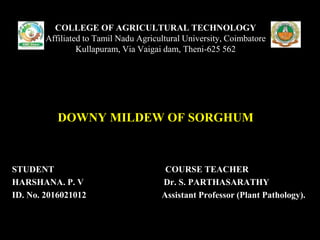
Downy Mildew of Sorghum
- 1. STUDENT COURSE TEACHER HARSHANA. P. V Dr. S. PARTHASARATHY ID. No. 2016021012 Assistant Professor (Plant Pathology). COLLEGE OF AGRICULTURAL TECHNOLOGY Affiliated to Tamil Nadu Agricultural University, Coimbatore Kullapuram, Via Vaigai dam, Theni-625 562 DOWNY MILDEW OF SORGHUM
- 2. DOWNY MILDEW SIGNIFICANCE • Sorghum Downy Mildew (SDM) is a highly destructive disease caused by soil borne fungus Peronosclerospora sorghi. • It can have a significant economic impact, as infection results in Plant death or lack of grain formation in panicle. • Sorghum Downy Mildew has been reported in 44 countries.
- 3. SIGNIFICANCE • It is endemic in many parts of sub-Saharan Africa, where it causes severe reductions in Corn and Sorghum yield. • The economic impact can be substantial as systemically infected plants are sterile. • This is demonstrated by the epidemics of Sorghum Downy Mildew in Venezuela in the early 1970s, which resulted in the epidemic being declared a National emergency.
- 4. ECONOMIC IMPORTANCE • Losses of US$ 2.5 million were caused in the coastal countries of Texas, with incidence in individual fields reaching 90% (Frederiksen et al., 1969). • In India, Payak (1975) reported losses of 1, 00, 000 metric tons.
- 5. GLOBAL DISTRIBUTION WORLD: Africa The Indian sub-continent South-East Asia North, Central and South America.
- 6. INDIA: Andhra Pradesh Delhi Haryana Karnataka Kerala Madhya Pradesh Maharashtra Rajasthan and Tamilnadu. DISTRIBUTION
- 7. GLOBAL DISTRIBUTION OF SDM
- 8. SYMPTOMS OF SDM • The fungus causes systemic downy mildew of sorghum. • It invades the growing points of young plants, either through oospore or conidial infection. • As the leaves unfold they exhibit green or yellow colouration.
- 9. • Abundant downy white growth is produced on the lower surface of the leaves, which consists of sporangiophores and sporangia. • Normally three or four leaves develop the chlorotic downy growth. SYMPTOMS OF SDM
- 10. • Subsequent leaves show progressively more of a complete bleaching of the leaf tissue in streaks or stripes. • As the infected bleached leaves mature they become necrotic and the interveinal tissues disintegrate, releasing the resting spores (oospores) and leaving the vascular bundles loosely connected to give the typical shredded leaf symptom. SYMPTOMS OF SDM
- 11. Pale yellow to light coloured streaked appearance ©pioneer.com
- 12. Parallel stripes of green and white tissues . Shredded appearance. ©pioneer.com
- 13. White (Downy)growth will occur on the underside of leaf tissue. Brown- coloured lesions. ©Pioneer.com
- 14. Kingdom Chromista Super Phylum Heterokonta Phylum Oomycota class Oomycetes order Sclerosporales Family Sclerosporaceae Genus Peronosclerospora Species P. sorghi SYSTEMATIC POSITION Peronosclerospora sorghi (W. Weston & Uppal) C. G. Shaw, (1978)
- 15. Downy mildew/Leaf shredding of Sorghum Crazy top - Sclerophthora macrospora (Sacc.) Thirumalachar et al. Syn. Sclerospora macrospora Sacc. Sorghum downy mildew - Peronosclerospora sorghi (W.Weston & Uppal) C. G. Shaw; Syn: Sclerospora sorghi W. Weston & Uppal
- 16. PATHOGEN -CHARACTERS • P. sorghi is an obligate parasite systemic in young plant. • The mycelium is intercellular, non-septate. • Sporangiophores emerge through the stomata in single or in clusters which are stout and dichotomously branched. • Spores are single celled, hyaline, globose and thin walled.
- 17. PATHOGEN • Oospores are spherical, thick walled and deep brown in colour. • P. sorghi has polycyclic disease cycle. • It is capable of causing secondary infection of the susceptible hosts throughout the growing season.
- 18. Asexual phase: Conidia (15.0-28.9 × 15.0-26.9 µm) are hyaline, thin-walled and suborbicular. Some conidia are in the process of germinating by a single, unbranched hyphal germ-tube. Sexual phase : Oospores (31.0-36.9 µm) are thick walled and spherical.
- 19. Asexual phase Mature conidiophore ©icrisat.org
- 20. DISEASE CYCLE OF SDM www.slideshare.net
- 21. EPIDEMOLOGY MODE OF SPREAD • Primary Infection: Oospores present in the soil. mycelium, seeds. Secondary Infection: Air-borne sporangia. • infected heads land on the later emerging florets and infect the frequent rain showers, high humidity and temperature. The disease is internally seed borne, where pathogen infects the embryo in the seed.
- 22. FAVOURABLE CONDITIONS • Relative humidity- 100% • Optimum temperature 21-23 °C. • Light drizzling. • Cool weather.
- 23. MANAGEMENT CULTURAL METHOD • Growing non-host or host crops (For example, oat, barley, flax, Sorghum sudanense or cowpea) for 15 days, and maize for 17 days reduced the inoculum potential in soils infested with oospores. • Deep tillage. • Roguing of diseased plants will reduce the oospore load in soil (Janke et al., 1983).
- 24. HOST- PLANT RESISTANCE • Sorghum, although a self- pollinated species can be induced to cross pollinate and thus lines with genetic uniformity and complete resistance to Sorghum Downy Mildew can be achieved (Frederiksen et al., 1973).
- 25. BIOLOGICAL METHOD • A Chytrid fungus (Gaertneriomyces sp.) was identified parasitizing oospores of P.sorghi (Kenneth, 1982). • It reduces incidence by upto 58% (Kunene et al., 1990). BOTANICAL METHOD • Leaf extracts of Prosopis chilensis and Azadirachta indica have also shown to have some efficiency (Kamalakannan and Shanmugam, 2009).
- 26. RESISTANT VARIETIES: Moderately Resistant varieties like Co25 Co26. TOLERANT VARIETY: Paiyur 2 CSH 2 CSV 5
- 27. CHEMICAL METHOD • Metalaxyl (Apron 35 SD) - Seed treatment @ 4g/kg of seed. • Foliar sprays will also prevent local lesions from developing on Sorghum foliage. • SAR agents including Phosphonic acid (Panicker and Gangadharan, 1999) may be useful in managing the disease where Metalaxyl resistance is problem.
- 28. REFERENCES • Saha, L. R., 2015. Handbook Of Plant Diseases. Kalyani Publishers, New Delhi. • Das, P.C., 2018. Plant Diseases. Kalyani Publishers, New Delhi.